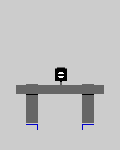Revolving lanterns are used for ordinary turnouts and derails. Single slip turnouts are equipped with 2 revolving lanterns. In rare instances, double slip turnouts are equipped with 1 or 3 revolving lanterns.
Movable-cover lanterns are used for double slip turnouts and 3-position ferry turnouts.
Symbols are usually white. A yellow symbol (introduced c. 1940) indicates
a facing turnout leading from a track with overhead wire to a track without.
Ordinary turnout: The turnout is set for the straight (non-diverging or least diverging) track. The signal usually has the same appearance to both directions of travel.
Derail: The derail can be passed. The signal has the same appearance to both directions of travel.
Double slip turnout with 1 lantern: The turnout is set for the crossing straight tracks. The signal has the same appearance to both directions of travel.
![]()
3-position ferry turnout: The turnout is set for the straight
(middle) track. The signal has the same appearance to both directions of
travel.
Ordinary turnout: The facing turnout is set for the diverging track as indicated by the arrow.
![]()
![]()
3-position ferry turnout: The facing turnout is set for a diverging
track as indicated by the arrow.
Ordinary turnout: The trailing turnout is set for the diverging track.
Ordinary turnout: The trailing, symmetric turnout is set for a diverging track as indicated by the crescent.
![]()
![]()
3-position ferry turnout: The trailing turnout is set for a diverging
track as indicated by the crescent.
The facing catch turnout is in derailing/protecting position.
This version was used in main tracks only. 1951, it was replaced by
no.
32.
The track behind the signal is inaccesible because of
- a facing catch turnout in derailing/protecting position, or
- a derail or eqv. in derailing/barring position.
Until 1951, no. 31 was used instead for facing turnouts in main tracks.
Until 1965, no. 32 was also used to indicate buffer-stops:

Double slip turnout with 1 revolving lantern: The turnout is set for the independent diverging tracks. The signal has the same appearance to both directions of travel.
The turnout is set for a straight track as indicated. The signal has the same appearance to both directions of travel.
The turnout is set for a diverging track as indicated. The signal has opposite appearance to the 2 directions of travel.
Theatre type signals were introduced c. 1950 for special double-slip turnouts, and later for ferry turnouts. Only the latter type is in service today.
Colour-light signals were introduced c. 1980 for ordinary turnouts, and later for double-slip turnouts. They are primarily used by private secondary lines, and are not very common.
Symbols are usually white. A yellow symbol may indicate a turnout leading from a track with overhead wire to a track without, but signals for this purpose have probably never been in service.
Ordinary turnout: The turnout is set for the straight (non-diverging or least diverging) track. The signal has the same appearance to both directions of travel.
![]()
2- or 3-position ferry turnout: The turnout is set for the straight (middle) track. The signal has the same appearance to both directions of travel.
Ordinary turnout: The facing turnout is set for the diverging track as indicated by the arrow.
![]()
![]()
2- or 3-position ferry turnout: The facing turnout is set for a diverging track as indicated.
Ordinary turnout: The trailing turnout is set for the diverging track.
2- or 3-position ferry turnout: The trailing turnout is set for a diverging track as indicated.
The turnout is set for a straight track as indicated. The signal has the same appearance to both directions of travel.
The turnout is set for a diverging track as indicated. The signal has opposite appearance to the 2 directions of travel.

![]()
![]()
Copyright © 2000 Henrik W Karlsson